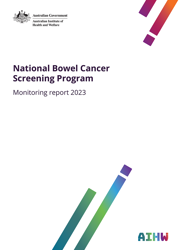Summary
The National Bowel Cancer Screening Program (NBCSP) began in 2006. It aims to reduce the morbidity and mortality from bowel cancer by actively recruiting and screening the eligible target population, aged 50–74, for early detection or prevention of the disease. This monitoring report is the eighth to examine the NBCSP using the current key performance indicators. It is estimated that in 2023 about 7,356 people aged 50–74 will be diagnosed with bowel cancer (around 48% of all bowel cancers diagnosed) and 1,864 people in this age group will die from the disease (around 35% of all bowel cancer deaths).
Participation
Of the 6.1 million people invited between January 2020 and December 2021, 40.9% participated in the program. The national participation rate was lower than the previous rolling 2-year period (2019–2020) of 43.8%. The re-participation rate for those who took part in their previous invitation round and received a subsequent screening invitation was 81.3%. For those who had ever previously participated, the re-participation rate was 73.8%.
Screening results
In 2021, 76,880 Australians returned a positive screening test, giving a 6% screening positivity rate. Of those who received a positive screening test, 86% reported a follow-up diagnostic assessment. The median time from positive screening test result to diagnostic assessment was 58 days.
Cancers and adenomas detected
As form return is not mandatory, diagnostic assessment data were not considered complete enough to allow formal performance indicator reporting. However, of the outcome data available for participants who had a diagnostic assessment in 2021, 1 in 27 were diagnosed with a confirmed or suspected cancer (83 and 521, respectively) and adenomas were diagnosed in a further 2,332 (1 in 7 participants assessed). Adenomas are benign growths with potential to become cancerous; their removal lowers the risk of future bowel cancers developing.
Population groups
Participants who identified as being of Aboriginal or Torres Strait Islander origin, those who lived in Very remote areas and those who lived in low socioeconomic areas all had higher rates of positive screens (warranting further assessment), but lower rates of follow-up diagnostic assessment, and a longer median time between a positive screen and assessment.
Since the NBCSP began
Since the program began in August 2006, about 10.1 million NBCSP screening tests have been completed, with about 4.5 million people participating at least once. Previous data linkage studies by the Australian Institute of Health and Welfare found that the NBCSP is contributing to reducing morbidity and mortality from bowel cancer in Australia (AIHW 2014a, 2018a, 2018b).
Summary
Data at a glance
1. Introduction
- Purpose of this report
- Bowel cancer facts
- Bowel cancer screening
2. Picture of bowel cancer in Australia
- Number of new cases
- Number of deaths
- Survival
- Burden of bowel cancer
3. Performance indicators
- Summary
- Recruitment
- Screening
- Assessment
- Diagnosis
- Outcomes
4. Bowel abnormality detection results
- Bowel abnormality detection using available assessment and histopathology data
5. Spotlight on population groups
- Low socioeconomic areas
- Very remote
- Aboriginal and Torres Strait Islander people
- Preferred language spoken at home
- Disability status
Appendixes
Appendix A: Data tables
Appendix B: Overall NBCSP outcomes
Appendix C: National Bowel Cancer Screening Program information
Appendix D: Data sources
Appendix E: Classifications
Appendix F: Methodology for calculating participation for population subgroups
End matter: Acknowledgements; Abbreviations; Symbols; Glossary; References; List of tables; List of figures; Related material.



